September 23, 2022
Air Date: September 23, 2022
FULL SHOW
SEGMENTS
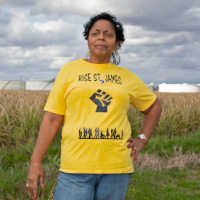
Victory in Cancer Alley
View the page for this story
Environmental justice advocates are declaring victory after a Louisiana judge canceled permits for a plastic factory in the region known as ‘cancer alley’ for the high rate of the disease linked to emissions from some 150 petrochemical plants. RISE St. James director and founder Sharon Lavigne joins Host Bobby Bascomb to talk about what the ruling means for this majority black community in the parish and the pursuit of environmental justice. (09:56)
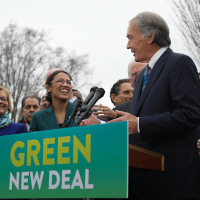
Federal Funds For Environmental Justice
View the page for this story
The 2022 Inflation Reduction Act contains billions of dollars aimed directly at addressing environmental and climate injustice. Democratic Senator Ed Markey of Massachusetts was one of the architects of those provisions and joins Host Steve Curwood to discuss how to ensure low-income communities and people of color can access those funds and programs. (11:34)
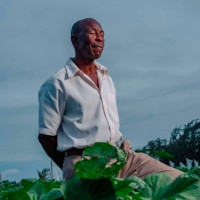
Upcoming Live Event on the Climate Debt Crisis
Living on Earth and ProPublica welcome you to join us online on October 4, 2022 at 3 p.m. Eastern for a free event, "The Climate Debt Crisis: How punishing debt stands in the way of small islands protecting themselves from climate change." Host Steve Curwood will moderate an in-depth discussion with ProPublica reporter Abrahm Lustgarten; Avinash Persaud, advisor to Barbados' Prime Minister Mia Mottley and leading thinker on development finance; and Colin Young, executive director of the Caribbean Community Climate Change Center. ()
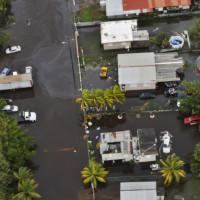
Fiona and Landslides
View the page for this story
When Hurricane Fiona recently struck Puerto Rico the island was still recovering from Hurricane Maria in 2017 and the swarm of earthquakes that started in 2019. Hurricane Fiona’s extreme rainfall and flooding triggered landslides in areas destabilized by the quakes, adding to the disaster. Marin Clark, Professor of Earth and Environmental Sciences at the University of Michigan, joins Host Bobby Bascomb to discuss. (08:08)

Beyond the Headlines
/ Peter DykstraView the page for this story
This week, Environmental Health News Editor Peter Dykstra and Host Bobby Bascomb discuss the discovery of harmful PFAS “forever chemicals” in some brands of dental floss. Also, decades after becoming locally extinct, cheetahs have been brought back to India. And in history, a look centuries back to when famous Portuguese explorer Ferdinand Magellan embarked on a circumnavigation of the world, though he didn’t actually make it all the way. (04:41)

Methane Supercharges Climate Change
View the page for this story
Scientists are sounding the alarm about a recent uptick in methane emissions. Methane is roughly 85 times more potent than CO2 as a greenhouse gas when it’s first emitted and reducing methane releases now may be one of the fastest ways to slow down climate change. Kristofer Covey, Assistant Professor of Environmental Studies and Sciences at Skidmore College, talks with Host Steve Curwood about the sources of this surge and how they can be addressed. (12:23)
Show Credits and Funders
Show Transcript
220923 Transcript
HOSTS: Bobby Bascomb, Steve Curwood
GUESTS: Marin Clark, Kristofer Covey, Sharon Lavigne, Senator Ed Markey
REPORTERS: Peter Dykstra
[THEME]
CURWOOD: From PRX – this is Living On Earth.
[THEME]
CURWOOD: I’m Steve Curwood.
BASCOMB: And I’m Bobby Bascomb.
Methane emissions have dramatically increased in the last two years, supercharging the climate crisis.
COVEY: Over the period of time that I’ve been interested in and studying the atmosphere methane levels in the atmosphere have increased about 15 percent. We’re up about 160 percent from pre-industrial levels so these increases are significant and they’re accelerating.
CURWOOD: Also, Senator Ed Markey on the Inflation Reduction Act.
MARKEY: This is not the bill I would have written, but it's the bill we need to start the process of the Green New Deal, in order to ultimately be the global leader that we have to be. We need this in order to go to the rest of the world later on this year and say, this is what we're doing; what's your plan?
CURWOOD: That and more this week on Living on Earth – Stick Around!
[NEWSBREAK MUSIC: Boards Of Canada “Zoetrope” from “In A Beautiful Place Out In The Country” (Warp Records 2000)]
[THEME]
Victory in Cancer Alley
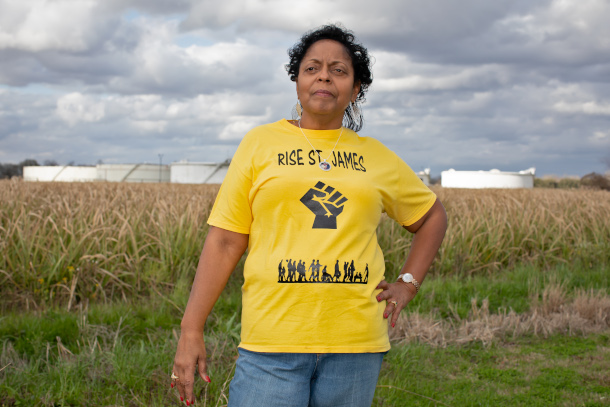
RISE St. James founder and director Sharon Lavigne stands in front of oil storage tanks in St. James Parish, Louisiana. (Photo: Courtesy of the Goldman Environmental Prize)
CURWOOD: From PRX and the Jennifer and Ted Stanley studios at the University of Massachusetts Boston this is Living on Earth, I’m Steve Curwood.
BASCOMB: And I’m Bobby Bascomb.
A state court in Louisiana has canceled permits for a controversial plastic factory along the Mississippi River in a region known as Cancer Alley for the high rate of the disease linked to emissions from some 150 petrochemical plants. In her ruling against Formosa Plastic, Judge Trudy White cited questionable data and environmental racism. Her decision blocks construction unless the company wins an appeal. Sharon Lavigne lives near the proposed factory in the predominantly black town of Welcome in Saint James Parish and organized the advocacy group Rise St. James to fight Formosa. We spoke with Sharon Lavigne when she won the 2021 Goldman Prize for her advocacy, and she joins us again now. Sharon, welcome back to Living on Earth!
LAVIGNE: It's good to be back. Thank you for having me.
BASCOMB: Now, first off, I have to say congratulations on this ruling that you've worked so so hard for.
LAVIGNE: Thank you. Thank you. I did work hard. I couldn't sleep at night, I still can't sleep at night.
BASCOMB: Oh, really?
LAVIGNE: Before I started this, I couldn't sleep because I kept wondering how I was going to beat them and how soon it was going to come. And when it came, I didn't expect it to come right in there. I thought it was, I thought it would have been like at the end of the year. But now since we won, it has to digest in your mind. It’s in your mind, but like still wondering if it's still if it's real. Even though I know it's real. But you know, in the back of your mind, you wonder, I mean, we claimed the victory. But Formosa and DEQ, they will challenge the judge's ruling. So we still have to wait to see how that's gonna go. But to me, we won.
BASCOMB: Well, that certainly is a step in the right direction. No doubt about that.
LAVIGNE: Hmm.
BASCOMB: Now I've read that the Formosa plant would have likely been the world's largest production facility for plastics, and it was supposed to be built about two miles or so from your home. Can you tell us please about the concerns you had with the plant that led you to dedicating yourself to fighting it?

Members of RISE St. James gather in the group’s first annual African American Celebration in St. James Parish, Louisiana. (Photo: Courtesy of the Goldman Environmental Prize)
LAVIGNE: Well, we have 12 industries and refineries within a 10-mile radius in my hometown. And Formosa would have brought in 14 more, so 12 plus the 14, we wouldn't be able to breathe the air. And we would not live, we would die off one at a time, or dozen at a time or everybody would die because the emissions that they would put out in the air, and the chemicals they would pollute the water with, soil would be more contaminated. So we would have more people with cancer, more people with asthma, more people with skin rashes. So we would have more deaths. So that's the way I saw it. And that's the way it would have been if they would have come in here.
BASCOMB: The Formosa plant was supposed to be placed in an area commonly known as Cancer Alley. And as you just alluded to, you know, there's roughly 150 petrochemical plants located there, each potentially a source of pollution hazardous to human health. Some estimates I've read, say that the plant could have doubled or even tripled the cancer-causing pollution in the area near the facility. But the state of Louisiana looked at that, they looked at the Formosa application and said, "Sure, come on in." They said the plant was going to create jobs and not be harmful to human health. What's your reaction to the state's position?
LAVIGNE: I think that that position with Formosa, they were misleading the people. They misled the governor, they misled our parish council. And the industry is not just Formosa, they come in here and paint a beautiful picture of how they're going to be good neighbors and how they're going to have so many jobs. And they're not going to pollute. That's misconception. When you look at the track record of Formosa, Formosa was a serial offender in Texas, Formosa is not wanted in Taiwan, and that's their hometown. So Formosa is lying to the people.
BASCOMB: And the state they didn't see through that lie as you did.
LAVIGNE: No I guess not. I don't know why because they didn't look at it the way I looked at it. And the public officials, they are in the pockets of industry. So when industry want to come in here, they welcome them in here. They don't do their research to find out the side effects of these of these chemicals. They don't do the research. They just take the industry's words for it. But I did my research. When I found out I had autoimmune hepatitis that was dealing with my liver, and it said it came from industrial pollutants. And that's mean all those 12 industries that we have in St. James in the fifth district where I'm from. So 14 more would have finished me off and a whole lot of other people off.
BASCOMB: Well, it sounds like Judge Trudy White in this case, she did do her homework. She looked at the case and ruled that the state was arbitrary in saying that no harm would come to local residents. And they didn't prove their case. They didn't provide enough information to back up the claim that the Formosa plant wasn't going to add more to the burden of people living there. To what degree were you surprised by her ruling? I mean, this has been a real David and Goliath fight you've been a part of here.
LAVIGNE: Yes, it was a David and Goliath fight it was. I remember going to Judge Trudy White hearing three times. In the last time, she told both parties to make a proposal and to have it to her on May 13th. I was in a court when she said that. And it took her all of these months. So I know she went through everything with a fine-tooth comb. And I'm glad she did. Maybe somebody else would have just glanced at it and say, "Oh, Formosa can still come in." But she thought about the people, how do people lives would be destroyed. So I think that was a good thing. And I think more judges should be like that. Not just give them a rubber stamp and tell them go ahead on and build there and pollute the people. So I commend Judge Trudy White for that.
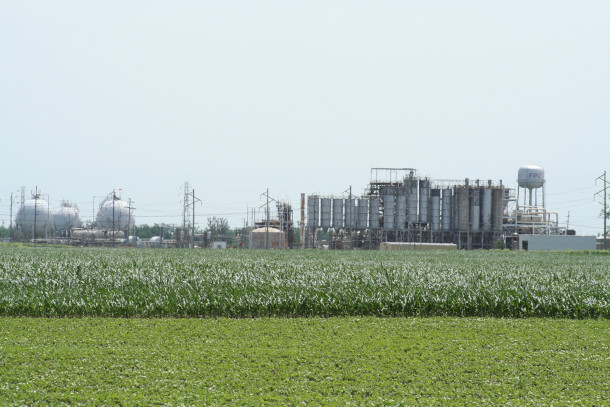
A photo taken in 2007 of the Formosa Plastics plant near Illiopolis, Illinois. An explosion occurred in the plant in April 2004, killing five workers and injuring two others. (Photo: Dual Freq, Wikimedia Commons, CC BY 3.0)
BASCOMB: And Formosa has said that they're planning to appeal Judge White's decision. What's next for them, do you think, and for you and the people you're working with there at RISE St. James?
LAVIGNE: We're gonna keep a close eye on it. And just trust in God, that is that Judge Trudy White decision, well, would not be be overturned. And that Formosa would leave and go somewhere, I don't know where, but not where people live. So we want to trust in God. We trust in God this far, and God is not going to leave us. He's not he's not going to forsake us. Because he told me to fight. So I know when he told me to fight, that meant no more is coming in. Because he wants people to live. You don't want people to die unnecessarily. That just like putting you in a gas chamber. When all those plants stop polluting. So God said, no more. So I feel confident that Judge Trudy White rulings will stand. I really do.
BASCOMB: Sharon, I have to ask you, what keeps you going? I mean, you've lost your home in a hurricane, you live in an area that's so unhealthy, you've had all these health problems. I mean, you won a Goldman Prize. It would be easy enough for you to just pack up and go somewhere else, you know, live a life of leisure, if you wanted to. What keeps you at this work?
LAVIGNE: There's no place like home. This is my home, this is where I want to be. I like the open space. I like the yard. I like we go outside on the front porch and just sit down, look at the red birds fly from one tree to the next. Look at your neighbors passing by waving at you. Some come by to sit down and talk to you. And I always like the open space. I don't like to live where my house and your house is two feet apart. Or three feet apart. I don't I don't want to live like that. I'm not used to that. So I like where I live. And I want to stay there. And I don't want any more industry to come in. And the ones that's in there, they better follow the guidelines, because we will be watching because too many people are dying. That's right. And these plants been there all those years. They've been polluting us all of those years. DEQ give some of them a pat on the back. So we are not going to allow that anymore. And I think DEQ need to be investigated. Because look all the plants they allowed to come in. Nobody challenged them. And I thank my parish council members, the ones that voted for Formosa, they need to be off the council. Because if you voted to kill me, that mean you don't care about me. And that means that we voted for you to be our parish council person. And you voted in favor of industry to destroy us. No, something is wrong with that. So RISE St. James have a lot of work to do. We have a whole lot of work to do. The work is just beginning because we are going deeper into all of this.
BASCOMB: Sharon Levine is director and founder of RISE St. James. Sharon, thank you so much for joining me today and for all of your hard work on this issue.
LAVIGNE: Thank you for having me. It was my pleasure.
Related links:
- About RISE St. James
- The YEARS Project | “Fighting Polluting Industry in Cancer Alley”
- Reuters | “Despite Court Ruling, Formosa Plans to Build Louisiana Plastics Plant”
- Read Judge Trudy White’s ruling against Formosa Plastics here
[MUSIC: Muddy Waters, “Louisiana Blues” on The Chess Box, UMG Recordings]
CURWOOD: Coming up – Elements of the Green New Deal in the Inflation Reduction Act. Keep listening to Living on Earth.
ANNOUNCER: Support for Living on Earth comes from Sailors for the Sea and Oceana. Helping boaters race clean, sail green and protect the seas they love. More information @sailorsforthesea.org. Support also comes from Friends of Smeagull the Seagull and Smeagull’s Guide to Wildlife. It’s all about the wildlife right next door to you! That’s Smeagull, S - M - E - A - G - U - L - L, SmeagullGuide.org.
[CUTAWAY MUSIC: Louis Armstrong “Tin Roof Blues - Live Edit (1955 Crescendo Club) on Highlights From His Decca Years, GRP Records]
Federal Funds For Environmental Justice
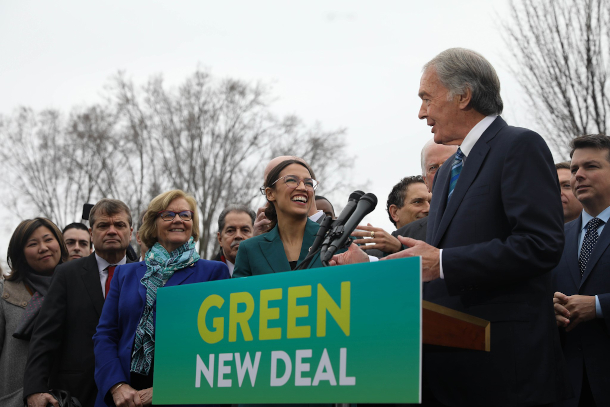
Senator Ed Markey (right) speaks on the Green New Deal with Representative Alexandria Ocasio-Cortez in front of the Capitol Building in February 2019 (Photo: Senate Democrats, Wikimedia Commons, CC BY 2.0)
BASCOMB: It’s Living on Earth, I’m Bobby Bascomb
CURWOOD: And I’m Steve Curwood
While the climate emergency and related fossil fuel pollution affects us all, low-income communities as well as people of color bear far more than their fair share of the negative impacts. These range from deadly summer heat in public housing linked to redlining, to higher asthma, cardiac problems and cancers related to unequal proximity to polluting highways and fossil fuel operations. Thanks to progressive House Democrats who called for a Green New Deal, the recently passed Inflation Reduction Act contains billions of dollars aimed directly at addressing environmental and climate injustice. Democratic Senator Ed Markey of Massachusetts was one of the architects of those provisions, and he joins us now. Welcome back to Living on Earth, Senator.
MARKEY: Great to be with you. It's an important time, obviously, for the climate.
CURWOOD: How much do you consider the Inflation Reduction Act to be a "New Deal"; the beginning of a new deal, at least?
MARKEY: It is a new deal. The Waxman-Markey bill passed the House of Representatives 219 to 212 in June of 2009. But then it died in the Senate, because 60 votes were needed in order to get it passed, and it stalled out at about 55 votes. The difference between 2009 and today is that by using the reconciliation process in the Senate, we were able to get it passed with 50 votes, and then Vice President Kamala Harris breaking the tie. So we don't need 60, we only need 51. And the second thing is that after Alexandria Ocasio-Cortez and I introduced the Green New Deal in February of 2019, it unleashed a movement of young people especially, age 18 to 34, all across this country, who made it very clear that their generation had been let down by the preceding generations. And that they wanted, yes, an identification of the problem; they wanted the technologies to solve the problem -- wind, solar, all-electric vehicles, battery storage technologies, new transmission systems -- but they wanted it done with environmental justice at the heart of it. So in a way, the 2009 bill was a down payment on the Green New Deal; although we didn't get it passed, it just, you know, laid out the framework to get it done. But then we finished the job here; well, we began to finish the job, to make sure that we get the communities who have been most adversely affected historically, the help that they need. The jobs, which they should have as well, as part of the solution. So this bill says, very simply, one, there will be a dramatic reduction in greenhouse gas. Two, we will create, according to the University of Massachusetts, upwards of 9 million new jobs. And third, that we do it with environmental justice, to make sure those communities historically left out are front and center. And young people in our country are leading us in that direction. And because of that, I have confidence, you know, that this bill finally, once and for all, will do it right.
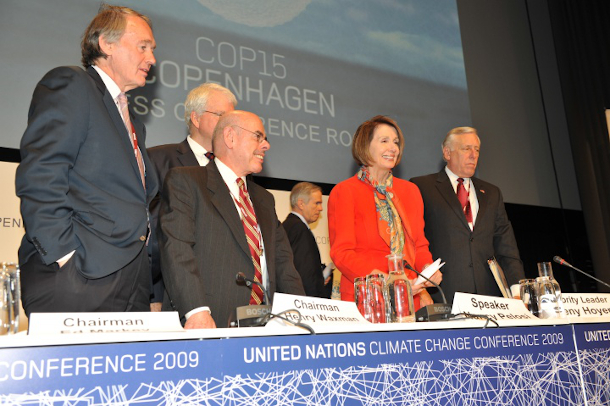
From left: Select Committee on Energy Independence and Global Warming Chairman Edward Markey, Energy and Commerce Committee Chairman Henry Waxman, House Speaker Nancy Pelosi, and Majority Leader Steny Hoyer held a press briefing at the COP15 UN Climate Conference in Copenhagen, Denmark in December 2009. (Photo: House Speaker Nancy Pelosi, Wikimedia Commons, CC BY 2.0)
CURWOOD: So the Inflation Reduction Act establishes a national climate bank, I think there's, what, $27 billion there to spur investment in projects that reduce global warming emissions. To what extent are disadvantaged communities going to be able to benefit from this green bank?
MARKEY: Yeah, and that's a great point. In the Waxman-Markey bill of 2009, we were able to include a climate bank, a green bank. So we have in this bill, now signed by the President, a $27 billion Greenhouse Gas Reduction Fund, a green bank, to create a program in which, to begin with, $15 billion will be targeted towards environmental justice communities. And also, I was able to get money along with Congresswoman from Missouri, Cori Bush, $30 million of funding for environmental justice mapping, so that we will be able to identify vulnerable communities that we need to invest in the most.
CURWOOD: Let me ask you a question and use the word "infrastructure," but in a different way. And what I mean is, in disadvantaged communities, who are the folks who are going to be able to understand the requirements to get this funding, indeed even help shape the requests for proposals, and then be able to write proposals so that these disadvantaged communities can get the money? I mean, one reason that richer places get the money is they have, you know, lawyers and consultants and such who know how to play the government game.
MARKEY: Well, yes, there's going to be a lot of wealthy constituencies in the country who are going to see this and all want to dip their straw into it. But what we have done is include $7 billion in grants for technical assistance for zero emissions technologies in disadvantaged communities. I think that's going to be something that, for example, John Podesta in the White House will be able to coordinate nationwide, that is, to ensure that the administration has direct outreach to those kinds of communities. It will have to be a massive grassroots effort to ensure that we go to where these most vulnerable communities are, and to meet them there. But I think that's why naming John Podesta as, essentially, the person overseeing the implementation of the $369 billion is so essential, because he played that role in the Clinton administration. He played that role in the Obama administration. He is somebody who understands how the federal government works across all agencies. And we're going to need discipline to ensure that each agency takes their part of this bill and targets those communities who have historically been most victimized by energy and environmental policy in our country.
CURWOOD: Yeah, so Senator, talk to me about the air quality monitoring money that's in the Inflation Reduction Act. I think it's about $236 million. Why is it key for disadvantaged communities to know what they're breathing, and how can that translate into cleaning up the air?
MARKEY: You know, Chelsea, Massachusetts is a great example of a community that actually never had air monitoring equipment in it until Congresswoman Ayanna Pressley and I advocated for, lobbied for, the EPA to install that equipment in Chelsea to monitor the impacts of pollution, on a community which is almost exclusively minority. I think that has to be a big part of what our goal is in implementing this bill, it is to make sure that as we dispense this funding, that the environmental justice mapping provision then ensures that there is a whole-of-government approach to find and to fix the climate harms in frontline communities. But that's going to require, you know, again, that we help those communities to be able to apply for these grants.
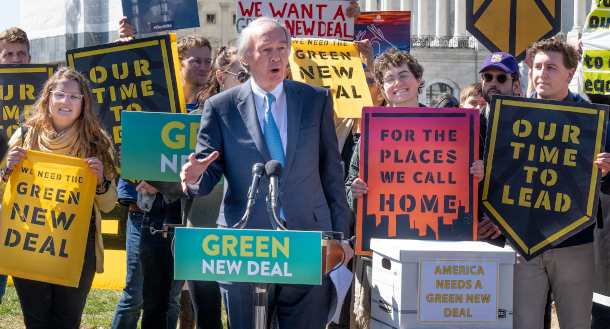
Senator Ed Markey (D-MA) at a rally for the Green New Deal on March 26th, 2019. (Photo: Victoria Pickering, Flickr CC BY-NC-ND 2.0)
CURWOOD: I'm glad you mention Chelsea, Massachusetts; as I understand it, not only does Chelsea have some of the most polluted air in Massachusetts, but it's got a poverty rate, what, about 20%? Looking ahead, how will you measure success in a place like Chelsea?
MARKEY: The goal has to be that because we know that air quality is still worse in historically redlined communities, that it's unacceptable. And we just have to ensure that we focus on a Chelsea, on a Lawrence, on a Brockton, on a Springfield to make sure they get the help that they need in order to be able to qualify for these grants, because we know the problem is there. For example, in Chelsea, idling diesel trucks by the scores in that community lead to much higher levels of exposure to pollution. They already have historically high asthma rates, which then unfortunately contributed to higher levels of COVID because they were both lung-related diseases. So ultimately, climate justice is going to be intersectional: racial justice, economic justice, social justice, health justice. And that's why this is important in Chelsea, because it's a perfect example of all of these problems coming together. And environmental issues are at the heart of all of it.
CURWOOD: Senator, I want to ask how you feel about all of this. I think it was back in 2008 that you led a special House Committee to look at climate disruption; and you and Henry Waxman got together and with Democratic votes, were able to get through your plan through the House. It did get tripped up by the filibuster in the Senate in 2009. You started that effort how many years ago? How do you feel now that the Inflation Reduction Act has finally been passed?
MARKEY: Well, sometimes you can be right, but too soon. So the bill that ultimately was killed by the fossil fuel industry in the Senate in 2009, it would have gotten us very close to where we're going to be in 2030. And we would have got there a lot sooner. But the way I view these issues is, politics is not for sprinters. It's a marathon. You have to stick with it. You have to have the courage of your convictions. And ultimately, our belief in wind and solar, in all-electric vehicles, has been confirmed. There were only 2,000 megawatts of solar in the entirety of the United States in 2009. In 2021, there were 24,000 megawatts of solar deployed in one year! There were only 2,000 all-electric vehicles in 2009. Today, every other ad on TV, watching the football games over this past weekend, were for some new company's new all-electric vehicle that they're trying to sell. So we have made a tremendous change in our country. And a lot of it actually came from Waxman-Markey even though it was not successful; it did change the whole discussion in the country; automotive industry, utility industry, they realized change was going to take place. So this is not the bill I would have written. But it's the bill we need, to start the process of the Green New Deal, in order to ultimately finish this project and be the global leader that we have to be. If we didn't have this, China, India, Brazil, they would just sit on the sidelines. So you cannot preach temperance from a barstool. So we need this in order to go to the rest of the world later on this year and say, “This is what we're doing. What's your plan?” And if we did not have this bill, there could be no credible plan which the United States could present in Egypt in November of this year.
CURWOOD: Ed Markey is the United States Senator from Massachusetts, he spoke to us from Washington D.C.
Related links:
- More on the Inflation Reduction Act from Senator Ed Markey
- A UMass Amherst analysis estimates the Inflation Reduction Act will create 9 million jobs
[MUSIC: Joshua Redman, Brad Mehldau, Brian Blade, Christian Mcbride, “Right Back Round Again” on Round Again, Nonesuch Records]
Upcoming Live Event on the Climate Debt Crisis
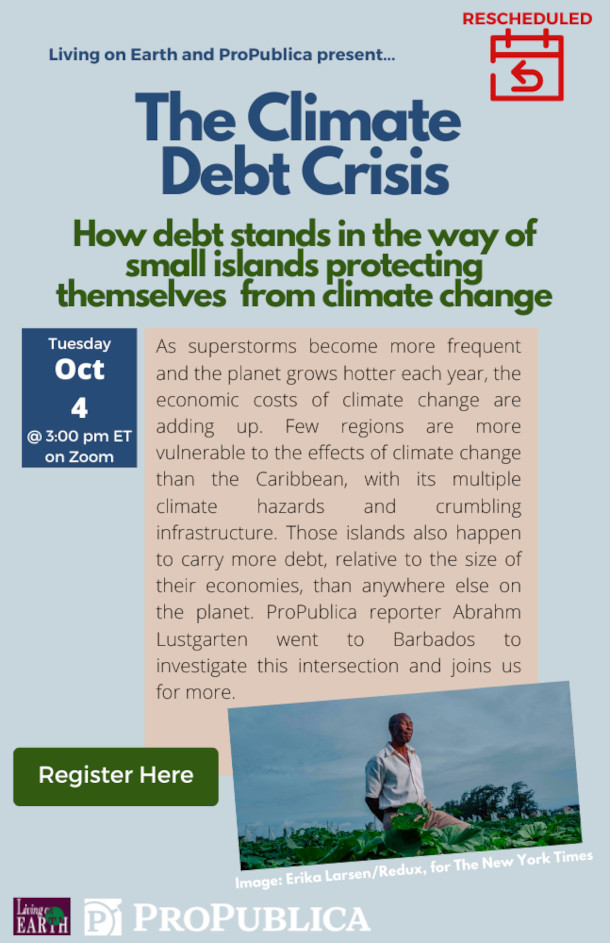
Join us on October 4th for a live event on the climate debt crisis.
CURWOOD: The Caribbean is especially vulnerable to costly climate impacts. But its islands also face punishing debt that makes it hard to adapt. Join us online on October 4th for a discussion about the climate debt crisis. Register for this free event at loe.org/events.
Related link:
Find out more and register for this upcoming live event
[MUSIC: Joshua Redman, Brad Mehldau, Brian Blade, Christian Mcbride, “Right Back Round Again” on Round Again, Nonesuch Records]
CURWOOD: The Caribbean is especially vulnerable to costly climate impacts. But its islands also face punishing debt that makes it hard to adapt. Join us online on October 4th for a discussion about the climate debt crisis. Register for this free event at loe.org/events.
[MUSIC: Joshua Redman, Brad Mehldau, Brian Blade, Christian Mcbride, “Right Back Round Again” on Round Again, Nonesuch Records]
Fiona and Landslides
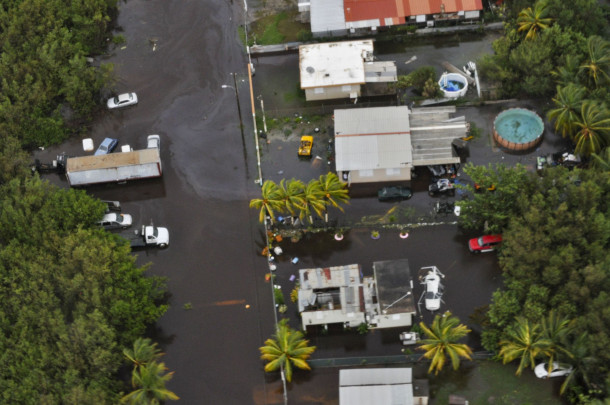
Hurricane Fiona devastated Puerto Rico with high wind speeds, flooding, and landslides. (Photo: Coast Guard News, Flickr, CC BY-NC-ND 2.0)
BASCOMB: Hurricane Fiona recently struck Puerto Rico, bringing upwards of 30 inches of rain, and cutting off some communities that are still struggling to recover from Hurricane Maria which leveled the island on nearly the same day five years earlier. Along with high winds and major flooding, the island has also been plagued by an onslaught of landslides. Marin Clark is a Professor of Earth and Environmental Sciences at the University of Michigan, and she joins me now for more. Professor Clark, welcome to Living on Earth!
CLARK: Thank you. I'm so glad to be here.
BASCOMB: Now, we're all familiar with the extreme rain and flooding that can come along with a hurricane. But landslides, I think are also a huge concern that maybe fly a little under the radar. What happened here most recently with Hurricane Fiona in Puerto Rico and landslides and what are you looking at right now?
CLARK: Yeah, so we expect that there were a lot all across the island. We're seeing some reports on social media of landslides blocking roads, damaging houses, but we're still in the really early stages about knowing just how widespread the problem is.
BASCOMB: And what exactly causes a landslide? Just to ask you a really basic question here.
CLARK: Sure. So in this case, the heavy rainfalls saturate the soil. And when the soil becomes saturated, it loses its strength, and it can no longer stay on the hillside and starts to move down slope, causing a landslide.
BASCOMB: And this part of the Caribbean also experienced an earthquake, right around the same time that Fiona hit the region. I think it was only a magnitude about 3.2. So not huge, but how did that contribute to the landslides that we're seeing?
CLARK: Well, more importantly, there was an earthquake that hit this area back in 2020. And it was a magnitude 6.4 earthquake. And it created about 300 landslides during this strong shaking. So that's another way to make a landslide is during an earthquake when the ground motion is really intense. That intense shaking can cause hillsides to become destabilized and cause a landslide. It was a pretty modest event, landslide event related to that earthquake, it affected the southern part of the island. But one thing that we know from other places in the world is that when you have an earthquake, and you create landslides during the strong shaking, that the other parts of the hillsides can remain vulnerable for periods of years after the earthquake, meaning that they're more susceptible to landsliding when a rainstorm or another earthquake comes in short succession. So most of the time we think about the rainstorms that follow the earthquakes as being really potentially damaging for at least a few years time frame. And that's exactly what has happened here in Puerto Rico.
BASCOMB: Well, what can Puerto Rico do to become more resilient to these landslides and the aftermath of extreme weather events?
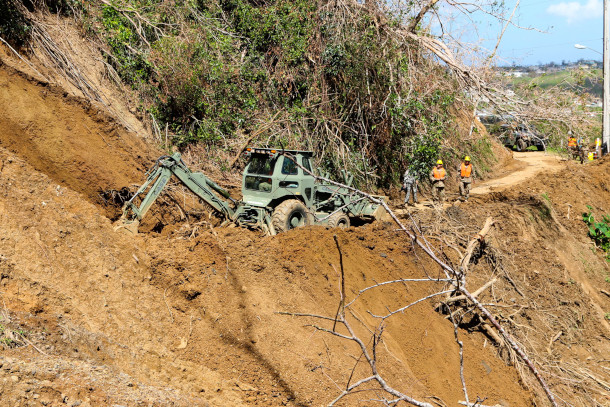
Hurricane Maria also caused landslides in Puerto Rico, such as this one which isolated 15 households by blocking roadways. (Photo: Sgt. Alexis Vélez, Puerto Rico National Guard, Flickr, CC BY 2.0)
CLARK: Yeah, that's an excellent question. So recently, the USGS and my collaborators at the University of Puerto Rico Mayagüez have installed a rainfall meteorological station monitoring network for landslides. In particular, across the island, they have about a dozen stations or so that just went online in the past year. And already, we know that one of those stations, as the scientists were watching the soil moisture conditions change, were able to get out reports to the local officials in that area to make some evacuations. And we know those evacuations were important and did save lives because there were landslides that impacted houses in that region just a few hours after that information was delivered from the weather station nearby. So we know that monitoring stations are important and can help provide life-saving information during an event like this. We also know that that kind of station data is really critical for also getting the scientific data that allow us to make better predictions in the future. And by that I mean, having ground truth data that we can compare it to satellite data, so that we can use satellite data in advance of a storm in order to make better predictions about which areas might be hard hit.
BASCOMB: Now Puerto Rico has seen a lot of development, which is often preceded by deforestation and clearing land. To what extent did removing native vegetation from the landscape exacerbate the landslides that we're seeing there?
CLARK: For sure land use changes do affect the stability of hill slopes. We know that removing the vegetation either by human activity or by natural causes, such as things like wildfires do contribute to stability problems and to increase landslides.
BASCOMB: Puerto Rico, of course, is not the only area of the world affected by landslides. What other countries or regions are you concerned about, you know, especially looking forward as scientists tell us to expect more extreme weather events with climate change?
CLARK: Yeah, I think that one thing about land surface hazards so landslides and river floods, they happen everywhere. And we also know that that threat's changing. It's increasing with climate change and with urban expansion into hilly and mountainous regions. So there's a lot of places on the globe that we're concerned about. One thing that we're thinking about right now is how hazards multiply. So for example, we know that in earthquake-prone regions like Puerto Rico, that it's not just the earthquake, that's of concern, but that an earthquake can then magnify another hazard. And so that gets to the point of earthquakes destabilizing slopes, making those slopes more fragile for a period of time after the earthquake, and making them more susceptible during a storm event like Hurricane Fiona. So Puerto Rico is definitely one of the places that has that kind of hazard multiplier in effect. California is another one. Additionally, we also think about wildfires as being another hazard that is one of these multipliers. And California has all three, it has earthquakes, and it has fires. And now we're thinking about these mega storms, these atmospheric rivers coming off the Pacific and hitting the coast. And so we're really thinking much more about the concept of how hazards interact. And with land surface hazards, they're especially sensitive to that hazard multiplier.
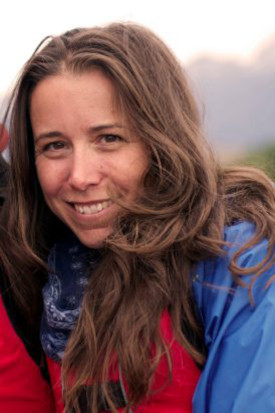
Marin Clark is the department chair of Earth and Environmental Sciences at the University of Michigan. (Photo: Courtesy of Marin Clark)
BASCOMB: What other regions of the world have that same set of circumstances?
CLARK: There are many places. The high topography in Himalaya is another place where they have major earthquakes. We know that the Himalaya are probably capable of a magnitude 8.5 or nine. And the steep mountains are landslide prone. And every summer, those mountains are hit by intense monsoon rains. So they also are a place where we see these types of interactions frequently.
BASCOMB: Now hurricanes obviously make the news. I mean, they're huge events or they can be, you know, everybody knows about them. But I think landslides people sort of think are you know, not such a big deal. They close the road for a day you deal with it. How do you see them though?
CLARK: Well, individual landslide and river flooding events are smaller, like you said, they don't tend to be as newsworthy as some of the other bigger hazards like flooding or earthquakes or volcanic eruptions. Landslides are everywhere. And they happen all the time. And so we think that the cumulative effects of these hazards are probably much more significant than we've paid attention to before.
BASCOMB: That’s Marin Clark, a Professor of Earth and Environmental Sciences at the University of Michigan.
Related links:
- Reuters | “Hurricane Fiona Swamps Puerto Rico, Knocking Out Power To Island”
- Marin Clark at the University of Michigan
- Click here to read a study cataloging Puerto Rican landslides after extreme storms
[MUSIC: Joshua Redman, Brad Mehldau, Brian Blade, Christian Mcbride, “Undertow” on Round Again, Nonesuch Records]
CURWOOD: Coming up – A recent surge in methane emissions has climate scientists sounding the alarm. Keep listening to Living on Earth.
ANNOUNCER: Funding for Living on Earth comes from you, our listeners, and United Technologies, combining passion for science with engineering to create solutions designed for sustainability in aerospace, building industries, and food refrigeration.
[CUTAWAY MUSIC: Brad Mehldau, “Exit Music” on Songs: The Art of the Trio, Vol. 3, Warner Records Inc.]
Beyond the Headlines

A test from Environmental Health News and wellness website Mamavation found that 13 out 39 brands of dental floss tested positive for a chemical linked to PFAS. (Photo: Marco Verch, Flickr, CC BY 2.0)
CURWOOD: It’s Living on Earth, I’m Steve Curwood.
BASCOMB: And I’m Bobby Bascomb.
Well, it's time for a trip now beyond the headlines with Peter Dykstra. Peter's an editor with Environmental Health News, that's ehn.org and dailyclimate.org. Hey there, Peter, what do you have for us today?
DYKSTRA: Well, hi, Bobby. We've talked a lot on the show about PFAS, the forever chemicals, as they're known and where they've been found in so many consumer goods. We got a new one for you: dental floss, particularly the waxy floss that goes through your teeth so easily. My organization EHN and the Mamavation website, it's a leading website for wellness, combined to test 39 different brands of dental floss, and 13 of those 39 tested positive for the PFAS chemical family linked to reproductive problems, birth defects, testicular cancer, and other maladies.
BASCOMB: Oh, gosh, well, I'll definitely have to check out that list, Peter. I mean, as you mentioned, PFAS are in just so many products that we are all exposed to all the time. Last thing we want to do is purposefully put it in our mouth every night when we're trying to do something good for our health. So do we have a list or something we can share with our listeners that will point them towards a dental floss that might be safe and, you know, not so painful?
DYKSTRA: All of the results of the EHN and Mamavation tests can be found on our website at loe.org.
BASCOMB: Well, we'll definitely have to check that out. What else do you have for us this week?
DYKSTRA: Well, we're looking at some potential, potential good news. We can never talk enough about the good news on the environmental beat when it comes along. But after 75 years of localized extinction, an experiment has brought cheetahs back to India. Seventy five years ago, they were wiped out. Now a modest population of eight cheetahs have been reintroduced to a national park.
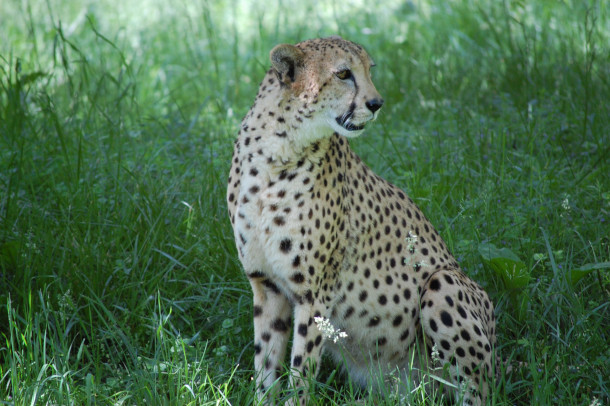
After decades of local extinction in India, eight cheetahs were recently welcomed into the country and released into a national park. (Photo: Sadie Hart, Flickr, CC BY 2.0)
BASCOMB: Wow, that is encouraging. I'm sure they are an important part of the ecosystem that's been missing all this time.
DYKSTRA: That's right, there used to be thousands of cheetahs in India. They were wiped out about halfway into the 20th century by hunting in other parts of Asia, in the Arabian Peninsula, and then much of Africa. But there are about 8,000 cheetahs, these magnificent animals, they remain in Namibia and neighboring countries.
BASCOMB: And how do they plan to protect them in India? I mean, they went extinct there once, how is this time going to be any different for them?
DYKSTRA: Well, these animals are in a national park, and hopefully the extra protection there will help them to thrive. One concern is anytime you have a population of eight animals, that may not necessarily be enough to breed survivors.
BASCOMB: I believe cheetahs are more or less solitary animals, so it's not like they're living in groups where they can easily find each other.
DYKSTRA: No, I mean, there have been similar problems with animals like even the blue whale, the largest animal in the world, ocean or land. The blue whales were hunted so intensively that they have a hard time finding each other. If you have that small a central population, you're going to have a really hard time breeding healthy animals.
BASCOMB: Well, let's wish them luck and take a look in the history books. What do you see for us this week?
DYKSTRA: We're gonna go way back in history to September 20, 1519. That is the date that a fleet of five ships under Captain Ferdinand Magellan left Portugal on what turned out to be the first successful circumnavigation of the world, at least by Europeans. The fleet was mostly sponsored by the king of Spain, and only one of Magellan five ships actually made it all around the world. And you know who didn't make it? Magellan.
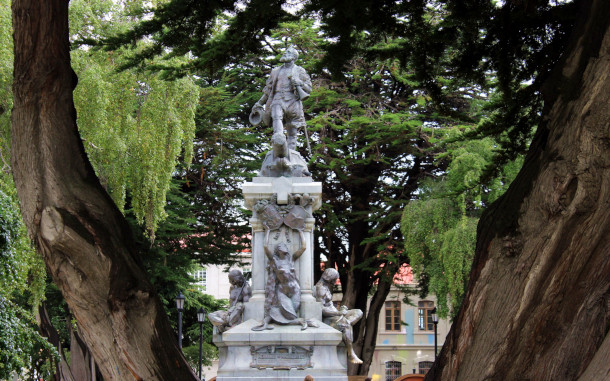
The monument of Ferdinand Magellan in Punta Arenas memorializes the famed Portuguese sailor and his exploration around the world. (Photo: Thomas Liptak, Flickr, CC BY-NC-ND 2.0)
BASCOMB: Oh, what happened to him?
DYKSTRA: Racism and conquest being a big part of what they did and what they were after, it's probably the reason that Magellan was killed by a poison arrow in the Philippines in the year 1521 when he was only 41 years old. He made it halfway around the world.
BASCOMB: Wow. So he didn't complete the trip, but he still gets the credit in the history books.
DYKSTRA: He does. And I couldn't tell you the name of the captain who actually made it back to Portugal.
BASCOMB: Exactly. All right. Well, thanks, Peter. Peter Dykstra is an editor with Environmental Health News, that's ehn.org and dailyclimate.org. We'll talk to you again real soon.
DYKSTRA: All right, Bobby, thanks a lot. Talk to you soon.
BASCOMB: And there's more on the stories on the Living on Earth website. That's loe dot org.
Related links:
- Environment Health News | “Tests Find PFAS Abundant in Some Dental Floss”
- The New York Times | “After 75 Years, Cheetahs Return to India in a Grand Experiment”
- Learn more about Ferdinand Magellan
[MUSIC: Spanish Guitar Chill Out, “Te Prometo” on Guitar Chill Out]
Methane Supercharges Climate Change
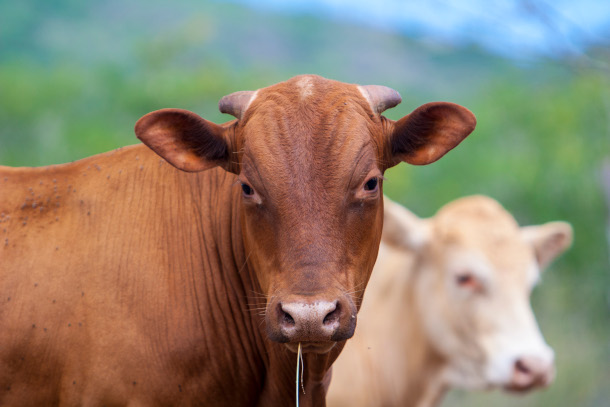
The recent surge in atmospheric methane has been largely attributed to microbial sources, such as cow burps and wetlands. (Photo: Spike Stitch, Flickr, CC BY-NC-ND 2.0)
CURWOOD: Methane is roughly 85 times more potent than CO2 as a greenhouse gas when it’s first emitted, and that is why scientists are sounding the alarm about a huge uptick in methane emissions that is supercharging planetary warming. Atmospheric methane eventually degrades in CO2 over a decade or so, but right now we are the decade that needs to cut total warming emissions in half, if the world has a chance to get to net zero by 2050 to avoid possibly catastrophic climate disruption. But methane emissions have been rising in recent years and are already responsible for roughly one third of human induced warming to date. So, reducing methane releases may be one of the fastest ways to slow down climate change. For some insight and perspective, we turn now to Kristofer Covey, Assistant Professor of Environmental Studies and Sciences at Skidmore College. Welcome back to Living on Earth!
COVEY: Hi, Steve, thanks for having me.
CURWOOD; Now, scientists have been tracking atmospheric methane for a while now. Talk to me about some of the history of recorded methane levels. How significant numerically is what appears to be recently a surge in the data over the last couple of years?
COVEY: Yeah, this most recent surge is significant on top of a set of increases that we've been looking at in the past decade. And so what we've seen is that since industrialization, since we started burning fossil fuels, we've been putting methane into the atmosphere, and we've been watching it go up. So we're going up every year, about six parts per billion, then a pause, then in 2007, a doubling of that rate now starting to head up. And then most recently, it looks like it's headed up again--those numbers now in the past couple of years looking like 15 parts per billion. That's on a historical background of about six parts per billion. And so over the period of time that I've been interested in and studying the atmosphere, methane levels in the atmosphere have increased about 15%. We're up about 160%, from pre-industrial levels, so these increases are significant. And they're accelerating.
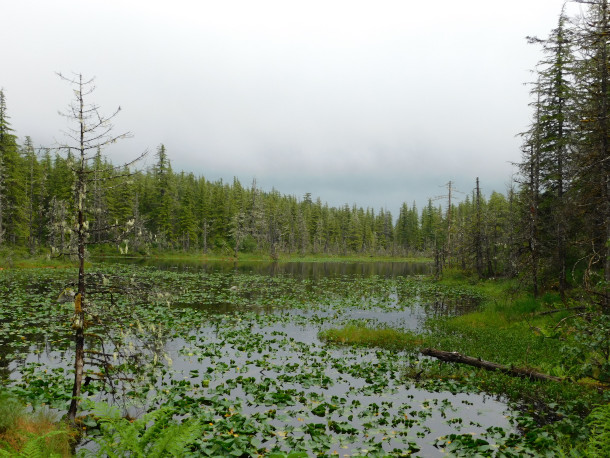
Humans are still the culprit behind many of these microbial sources of methane. For example, anthropogenic global warming has melted permafrost across the globe, resulting in more methane-emitting wetlands. (Photo: Jimmy Emerson, DVM, Flickr, CC BY-NC-ND 2.0)
CURWOOD: How have you been able to measure the releases of methane, and where are the hotspots around the world?
COVEY: So methane is slippery to measure. Some emissions are very concentrated sources where it's very easy to detect. And then you have sources which are very diffuse, you know, they're happening over huge areas, and they change very quickly through time; it rains and the emission goes up, it dries out and the emission goes down. And so on the ground estimates are really difficult. We do the best we can with trying to put a box around some kind of a source. Picture putting a bag around a cow, seeing how much methane comes out of it, and then multiplying by the number of cows, right? That's one way to get a number. That's what we call bottom-up budgeting. We also do a lot of top-down budgeting, where you go up into the atmosphere, and you measure how much methane is in there. And you measure its isotopic ratios. And then you try and piece those two things together over long periods of time, into a coherent story.
CURWOOD: What about regionally? I've heard that Russia has a large proportion of methane emissions. Of course, they also have the largest taiga forest on the planet, they've got an awful lot of permafrost, and they crank out a lot of natural gas and fossil fuel.
COVEY: Yeah, this is actually another part of the puzzle is that using satellites, we can measure methane concentrations in the atmosphere. And we can do that geospatially. We can see pockets where methane is higher. We see, for instance, over tropical rain forests, lots of methane in the atmosphere. We see similar pockets over places that have large fossil fuel emissions. And that's one way that we can try to trace back where emissions are coming from and whether they match emissions that are being reported. So for example, former Vice President Al Gore has an initiative he's been helping to lead with a bunch of other global leaders and scientists called Climate Trace, where they are trying to estimate sources of methane at a country scale remotely. Russia and China, for example, are likely underreporting their methane emissions for trying to meet their targets or for reporting their sort of contributions to methane budgeting, and these are things that we can detect now in the atmosphere and start to make accounting verifiable remotely.
CURWOOD: Why are methane emissions accelerating right now and fast, you say?
COVEY: What's really interesting about this most recent spike is that it appears to us that it's coming from microbial sources, so things like wetlands, and we see a large signal over the tropics. And so it looks to us like this is coming from the natural environment, as opposed to sources from fossil fuel emissions. That said, that doesn't mean that these aren't anthropogenically driven, that people aren't causing these emissions, just that the source is clearly microbial. You have sources for instance like cow burps, where the activity inside the rumen of a cow is driven by microbes. But why is that cow there? That cow is there because humans wanted to eat it and humans are growing it. Also we flood areas for rice cultivation, for example, or to make hydroelectric dams, and when we flood new land and make a hydroelectric dam, there's an associated large pulse of methane into the atmosphere. That pulse is microbial, but it's also anthropogenic.
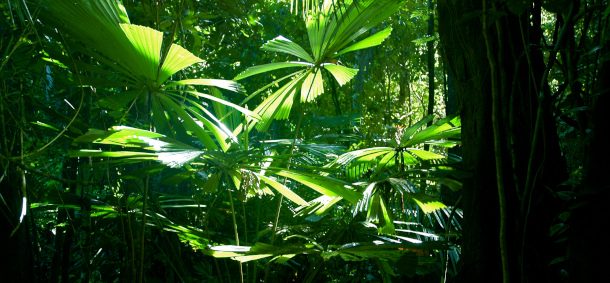
Scientists can use satellites to map “hotspots” of methane emissions in the atmosphere, one of which appears to be the tropics. (Photo: ben britten, Flickr, CC BY 2.0)
CURWOOD: Now you've done some work on how clearing of tropical rain forests releases greenhouse gases. To what extent is deforestation, do you think, by humans, driving this sort of natural or microbial form of methane?
COVEY: The big pulse you get from deforestation are carbon emissions. However, a lot of what follows forest clearing is really important to think about as well. So for example, most of the Amazon, when we're clearing that, a big portion of that anyway is going to agriculture and there are a lot of methane emissions associated with that process. About a third of anthropogenic emissions are from cows.
CURWOOD: What could be done to change agriculture to reduce methane emissions?
COVEY: Yeah, so certainly, we could eat less meat. That is one way we could have fewer cows. There are also methods of growing cows that produce less methane. It looks like you get less methane from grass fed cows. There is some evidence that adding additives to their diet out of seaweed reduces methane emissions. So there are some of the sort of cultural shifts and technological shifts in cattle production, for example, that show promise to reducing emissions. And so small changes over big areas make a big difference. Our agricultural system is an enormous driver of climate change. And there's a lot of focus right now on regenerative agriculture and its ability to turn what is a climate problem into a climate solution. And so the entire agricultural system is a huge climate conversation.
CURWOOD: There has been a lot of concern expressed that this increase in methane may be coming from the colder regions of the world-- that as we have warmed up the Arctic region, actually much faster than many other parts of the world, that maybe some of that permafrost is starting to thaw out and start to release methane. How important do you think that might be as a source for these increased emissions?
COVEY: As with a lot of these big global atmospheric questions, there's still a lot of that to refine. But the near term, the indications are that a significant portion of this warming is coming from that effect, that we have thawing permafrost. And when that thaws, that creates a bunch of liquid water, which then spreads out over the landscape. And these become wetlands. And those wetlands are a huge source for atmospheric methane. And we have seen that inland lake area in inland Alaska has increased 40% over pre-industrial. So we are melting that permafrost and we're turning it into an engine for greenhouse gas emissions right now.
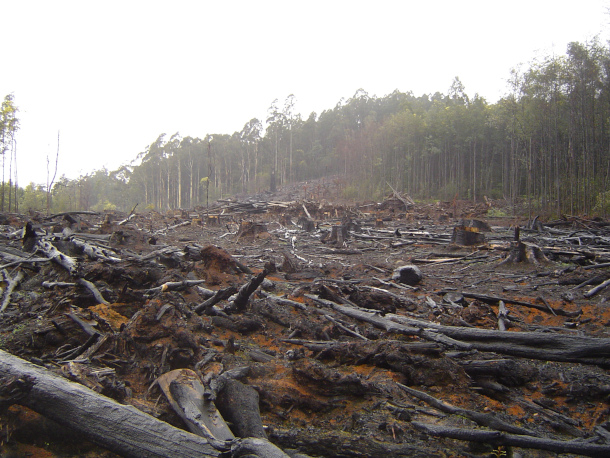
Humans are bulldozing the tropics to pursue agriculture, which is associated with high methane emissions. (Photo: crustmania, Flickr, CC BY 2.0)
CURWOOD: So underneath the oceans are these big sort of pods of frozen methane. Some people call them methane hydrates, refer to them as clathrates. What exactly are these? And what are the potential consequences of these finding their way into the atmosphere? Some people talked even about trying to extract them, use that in commerce.
COVEY: Yeah, well, they're just that. They're these sort of cooled pockets of methane inside the oceans. I have certainly heard of folks thinking about mining these as a resource. But more often than not, when we hear about these, we hear about them in the context of tipping points or runaway feedback effects, tail risk of climate change, where as you warm the ocean, these hydrates then become less stable in the water. And they're released, potentially quite rapidly. And so this is one of those situations where you can define very realistic scenarios where warming begets further warming, which then begets further warming.
CURWOOD: Professor, what would the world look like in 10, or 50, or 100 years if this methane surge just continues the way that it's going?
COVEY: Well, that's a really difficult question. And I think difficult, both analytically from a scientific perspective, to look that far in advance. These are tremendously complex systems. And it's also difficult emotionally. Because I find it hard to want to picture what that world would look like. From what I see on the ground and what I see the direction of the atmosphere that looks like where we're headed, and where increasingly large portions of the Amazon transition from being the largest tropical rainforest in the world, a global icon to being a savanna, a relatively dry tropical savanna. I think we're starting to see changes in permafrost that don't look good. Look at what is happening right now in the American West with huge sections of the American West under this heat dome. Look at these fires that we're watching. You know, every year is another catastrophic fire season in California. I was talking to my students just yesterday about this, that you know, another town burned down in California, and one student had heard of that. The worst fire seasons in history are becoming a "dog bites man" story. This is happening now.
CURWOOD: So what steps does the world need to take to reduce methane emissions? Especially given how urgent, how difficult this climate emergency is already? What are the options?
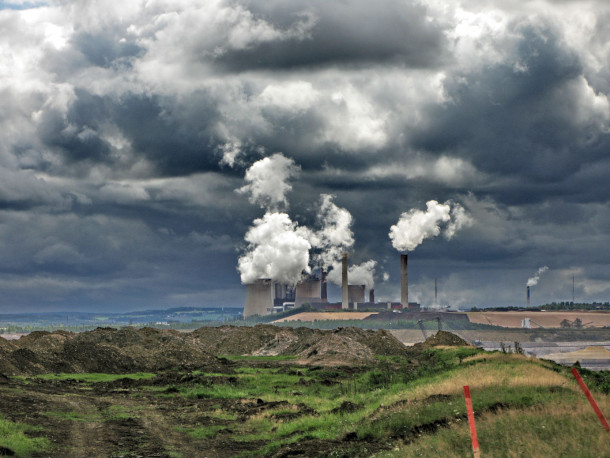
Under the Inflation Reduction Act, domestic producers will be charged $900 per metric ton of methane emissions in 2024, scaling up to $1500 per metric ton in 2026. (Photo: glasseyesview, Flickr, CC BY-SA 2.0)
COVEY: Well, I see some positive steps there. We saw coming out of COP26, the Global Methane Pledge. They've got a host of countries that represent about half of all global emissions of methane signed on to that, to commit to a 30% reduction. It's not great that we're missing China, Russia and India, who are the top three emitters from that, but that is a significant goal. A target has been set. And something that sort of flew under the radar in the Inflation Reduction Act, this new climate bill, was a sort of carrot and stick approach to the first time regulating methane emissions. And included in the IRA is a price that keys in in 2024. We see a price of $900 a metric ton on domestic producers for emissions of methane. That scales up to $1,500 a metric ton in 2026. That's the stick part. But coupled with that is this basket of $1.5 billion in subsidies to oil and gas to make improvements that reduce these methane emissions. So saying to these companies, “Hey, we'll pay for your transition so that you don't have to pay this fairly hefty tax per metric ton.” So I think some positive steps taken. I think we need to see investments obviously continue in solar and wind and reductions in fossil fuels. I think it would be really interesting to see what we can do if we make huge investments in direct capture technology for methane. That needs a lot of work. It's not today, but climate change--there's no single solution. And there doesn't appear to be anything that's going to fix this right away. And so we need to invest in solutions that are going to mature today and solutions that are going to mature in 10 and 20 years. We're still going to be fighting this for a long time.
CURWOOD: Christopher Covey teaches at Skidmore College. Thanks so much for taking the time with us today.
COVEY: Thanks, Steve. Really grateful to be with you.
Related links:
- Global Monitoring Laboratory | “Trends in Atmospheric Methane”
- Environmental Protection Agency | “Understanding Global Warming Potentials”
- Global Carbon Project | “Global Methane Budget”
- Global Methane Pledge | “About the Global Methane Pledge”
- Global Methane Assessment | “Benefits and Costs of Mitigating Methane Emissions”
- Congressional Research Service | “Inflation Reduction Act Methane Emissions Charge: In Brief”
- Climate Trace | “Climate Trace”
[MUSIC: John Coltrane, “Equinox” on Naima, Warner Music Group]
CURWOOD: Living on Earth is produced by the World Media Foundation.
Our crew includes Naomi Arenberg, Paloma Beltran, Chloe Chen, Iris Chen, Josh Croom, Jenni Doering, Mark Kausch, Kuka Kahfi, Mark Seth Lender, Don Lyman, Louis Mallison, Aynsley O’Neill, Sophia Pandelidis, Jake Rego, Hannah Richter, Ashley Soebroto, and Jolanda Omari.
BASCOMB: Tom Tiger engineered our show. Alison Lirish Dean composed our themes. You can hear us anytime at L-O-E dot org, Apple Podcasts and Google Podcasts, and like us, please, on our Facebook page - Living on Earth. We tweet from @livingonearth. And find us on Instagram at livingonearthradio. I’m Bobby Bascomb.
CURWOOD: And I’m Steve Curwood. Thanks for listening!
ANNOUNCER: Funding for Living on Earth comes from you, our listeners, and from the University of Massachusetts, Boston, in association with its School for the Environment, developing the next generation of environmental leaders. And from the Grantham Foundation for the protection of the environment, supporting strategic communications and collaboration in solving the world’s most pressing environmental problems.
ANNOUNCER 2: PRX.
Living on Earth wants to hear from you!
Living on Earth
62 Calef Highway, Suite 212
Lee, NH 03861
Telephone: 617-287-4121
E-mail: comments@loe.org
Newsletter [Click here]
Donate to Living on Earth!
Living on Earth is an independent media program and relies entirely on contributions from listeners and institutions supporting public service. Please donate now to preserve an independent environmental voice.
NewsletterLiving on Earth offers a weekly delivery of the show's rundown to your mailbox. Sign up for our newsletter today!
 Sailors For The Sea: Be the change you want to sea.
Sailors For The Sea: Be the change you want to sea.
 The Grantham Foundation for the Protection of the Environment: Committed to protecting and improving the health of the global environment.
The Grantham Foundation for the Protection of the Environment: Committed to protecting and improving the health of the global environment.
 Contribute to Living on Earth and receive, as our gift to you, an archival print of one of Mark Seth Lender's extraordinary wildlife photographs. Follow the link to see Mark's current collection of photographs.
Contribute to Living on Earth and receive, as our gift to you, an archival print of one of Mark Seth Lender's extraordinary wildlife photographs. Follow the link to see Mark's current collection of photographs.
 Buy a signed copy of Mark Seth Lender's book Smeagull the Seagull & support Living on Earth
Buy a signed copy of Mark Seth Lender's book Smeagull the Seagull & support Living on Earth

